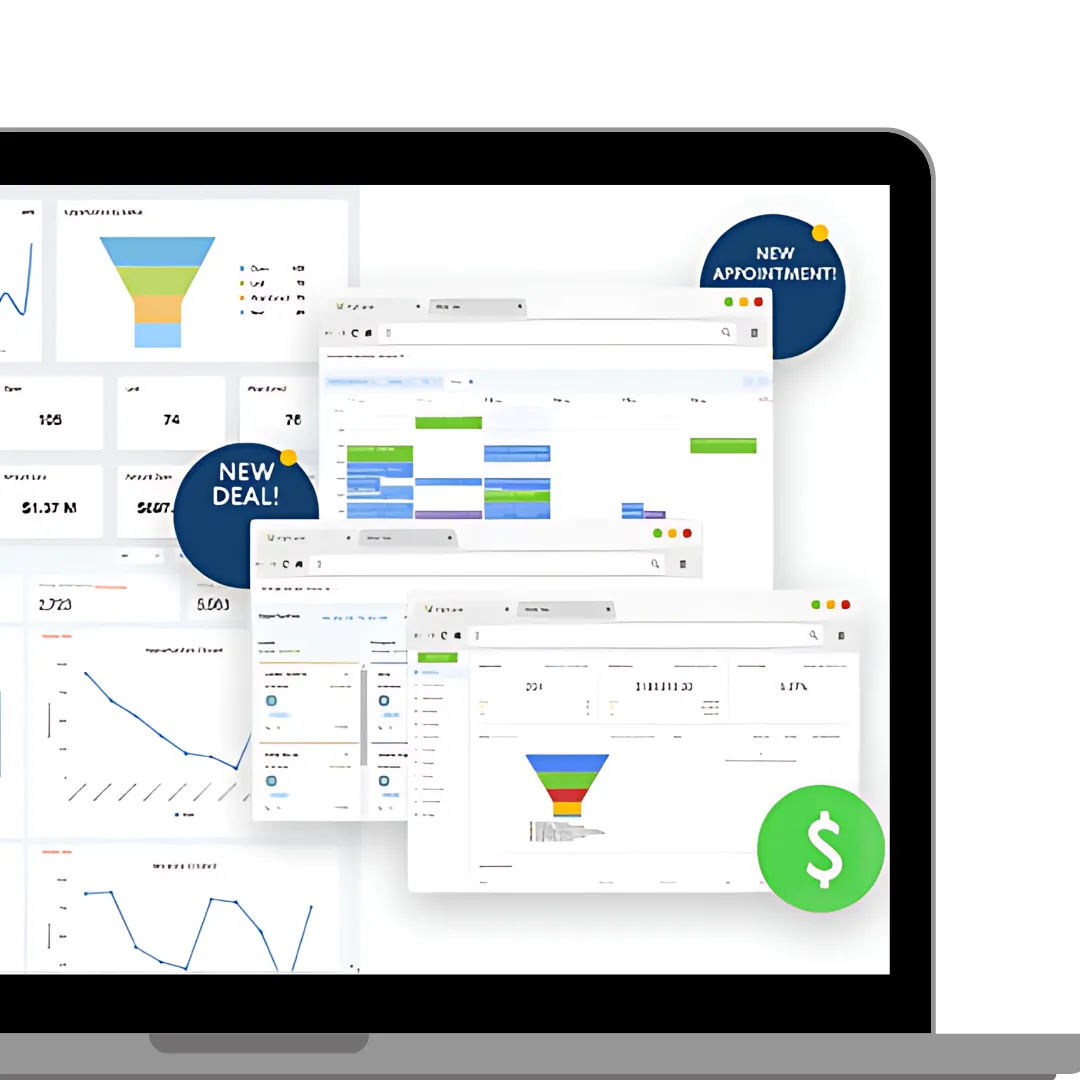
The Power of Personalized Marketing: Boost Customer Engagement and Loyalty
The Power of Personalized Marketing: Boost Customer Engagement and Loyalty
Understanding Personalized Marketing
Personalized marketing is reshaping the way businesses connect with their customers. This section delves into the concept, its benefits for small businesses, and the key elements that contribute to its effectiveness.
What is Personalized Marketing?
Personalized marketing is a strategy that customizes content, products, and services for individual customers based on their preferences, behaviors, and data. It transcends simple segmentation to create unique experiences for each customer.
This strategy uses customer data to deliver highly relevant messages across multiple touchpoints. As a result, businesses can significantly enhance engagement and conversion rates.
The objective is to make each customer feel valued and understood, strengthening relationships and brand loyalty. Personalized marketing encompasses a range of strategies, from customized email campaigns to product recommendations and tailored website experiences.
Benefits for Small Businesses
Small businesses can reap substantial benefits from personalized marketing strategies. By adopting these tactics, they can compete more effectively with larger rivals and forge meaningful connections with their audience.
A primary advantage is increased customer engagement. When content resonates with a customer’s specific needs and interests, they are more likely to interact with the brand and make a purchase.
Personalization also promotes better customer retention and loyalty. By making customers feel understood and valued, they are more likely to become repeat buyers and brand advocates. This can lead to a higher customer lifetime value and reduced acquisition costs.
Additionally, personalized marketing often results in higher conversion rates and a better return on investment (ROI). By targeting the right customers with the right message at the right time, small businesses can optimize the effectiveness of their marketing budget. Learn more about these benefits at ECI Solutions.
Key Elements of Personalization
Effective personalization relies on several key elements that work in harmony to create a tailored customer experience. Understanding and implementing these elements is vital for success.
Data Collection and Analysis: The foundation of personalization lies in gathering and analyzing customer data, including demographic information, purchase history, browsing behavior, and preferences.
Segmentation: Dividing your audience into distinct groups based on shared characteristics allows for more targeted messaging and offers.
Dynamic Content: Creating content that adapts based on user behavior or preferences ensures relevance across all touchpoints.
Automation: Utilizing marketing automation tools enables delivery of personalized content at scale, ensuring timely and relevant communications.
Continuous Testing and Optimization: Regularly analyzing the performance of personalized campaigns and making data-driven improvements is crucial for long-term success.
For a deeper exploration into crafting personalized strategies, visit Buzzboard’s guide.
Leveraging Customer Feedback
Customer feedback is a treasure trove of valuable insights that can inform and drive personalization efforts. This section explores the significance of feedback optimization and provides guidance on effectively gathering and leveraging customer insights.
Importance of Feedback Optimization
Optimizing customer feedback is critical for refining personalized marketing strategies. It provides direct insights into customer preferences, pain points, and expectations, enabling businesses to tailor their offerings more effectively.
Feedback optimization allows businesses to remain agile and responsive to evolving customer needs. By continuously collecting and analyzing feedback, companies can identify trends and adjust their strategies in real-time.
Moreover, actively seeking and responding to feedback demonstrates to customers that their opinions are valued, fostering trust and loyalty, key components of successful personalized marketing campaigns. For more on leveraging feedback, visit Lead Magno’s resources.
Tools for Gathering Insights
Effective insight gathering requires the right tools and methodologies. Here are some essential tools for collecting customer feedback:
Surveys and Questionnaires: These tools can gather specific information about customer preferences and experiences.
Social Media Monitoring: Tracking mentions and engagement on social platforms provides real-time insights into customer sentiment.
Customer Reviews and Ratings: These provide valuable feedback on products and services, highlighting areas for improvement.
Analytics Tools: Website and app analytics offer data on user behavior and preferences.
Customer Service Interactions: Direct communications with customers frequently reveal valuable insights that can inform personalization strategies.
Implementing a mix of these tools ensures a comprehensive view of customer feedback. For advanced analytics solutions, consider exploring TechMagno’s offerings.
Turning Feedback into Action
Collecting feedback is just the initial step; the real value lies in translating these insights into actionable strategies. This involves careful analysis and strategic implementation.
Begin by categorizing feedback into themes or areas of concern. This helps identify patterns and prioritize actions. Next, develop specific action plans for each key area, ensuring that the changes align with your overall personalization strategy.
It’s crucial to close the feedback loop by communicating changes back to customers. This shows that their input is valued and acted upon, reinforcing their connection to your brand.
Feedback implementation should be an ongoing process. Regularly review the impact of changes and continue refining your approach as new insights emerge. For more on turning feedback into effective strategies, check out The Small Business Expo’s guide.
Multi-Channel Marketing Approach
A multi-channel approach is essential for executing effective, personalized marketing. This section explores the integration of online and offline strategies, the role of social media, and the importance of diversifying customer touchpoints.
Online vs Offline Strategies
In today’s digital age, successful personalized marketing requires a balance between online and offline strategies. Each channel offers unique advantages and reaches customers in different contexts.
Online strategies leverage digital platforms to deliver personalized content quickly and at scale, including email marketing, social media campaigns, and tailored website experiences. They provide real-time engagement and easy tracking of customer interactions.
Offline strategies, though sometimes overlooked, are crucial for creating tangible and memorable experiences. These can include personalized direct mail, in-store experiences, or event marketing. Offline methods can create a more personal touch that complements digital efforts.
The key is to create a seamless experience across both online and offline channels, ensuring consistent messaging and branding. For insights on balancing these strategies, visit Lead Magno’s demo page.
Integrating Social Media Campaigns
Social media platforms provide powerful tools for personalized marketing, allowing businesses to engage with customers in real-time and deliver targeted content to specific audiences.
Effective social media integration involves:
Platform Selection: Choose platforms where your target audience is most active.
Content Customization: Create platform-specific content that resonates with each audience segment.
Engagement Strategies: Develop tactics for fostering two-way communication with followers.
Data Utilization: Use social media analytics to refine your personalization efforts.
Remember, social media isn’t just a broadcasting tool; it’s a means of building relationships. Encourage user-generated content and respond promptly to comments and messages to create a community around your brand.
For creative ideas on social media integration, explore Lead Magno’s graphic design services.
Diversifying Touchpoints for Engagement
Diversifying customer touchpoints is crucial for crafting a comprehensive personalized marketing strategy. It ensures you reach customers through their preferred channels and at various stages of their journey.
Consider the following touchpoints:
Website: Personalize content based on user behavior and preferences.
Email: Send targeted campaigns based on customer segments and past interactions.
Mobile Apps: Offer personalized notifications and in-app experiences.
Physical Stores: Train staff to provide personalized service based on customer data.
Customer Support: Equip support teams with customer information for tailored assistance.
The goal is to create a cohesive experience across all touchpoints, reinforcing your personalized messaging and brand identity. This omnichannel approach ensures customers receive consistent, personalized interactions, regardless of how they engage with your business.
For more on creating diverse engagement strategies, check out Hoppier’s guide.
Building Brand Loyalty
Brand loyalty is the ultimate goal of personalized marketing. This section explores strategies for creating loyalty incentives, leveraging social proof, and implementing effective referral programs.
Creating Loyalty Incentives
Loyalty incentives are powerful tools for encouraging repeat business and fostering long-term customer relationships. These programs reward customers for their continued patronage, creating a sense of value and appreciation.
Effective loyalty incentives can take many forms:
Points Systems: Customers earn points for purchases, which can be redeemed for discounts or products.
Tiered Programs: Offer increasing benefits as customers reach higher loyalty levels.
Exclusive Access: Provide loyal customers with early access to new products and special events.
Personalized Rewards: Tailor rewards based on individual customer preferences and purchase history.
The key is to make these incentives feel personal and valuable to each customer. Use data from past interactions to customize rewards and ensure they align with customer interests.
For more ideas on creating compelling loyalty programs, visit ECI Solutions’ blog.
Influence of Social Proof and Collaborations
Social proof and collaborations play a significant role in building brand loyalty through personalized marketing. They leverage the power of community and trusted voices to reinforce your brand’s value.
Social proof can be incorporated in several ways:
Customer Reviews and Testimonials: Showcase positive feedback from satisfied customers.
User-Generated Content: Encourage and feature content created by your customers.
Influencer Partnerships: Collaborate with influencers who resonate with your target audience.
Collaborations, whether with influencers or complementary brands, can expand your reach and add credibility to your personalized marketing efforts. These partnerships should align with your brand values and appeal to your target audience.
Remember, authenticity is key in leveraging social proof and collaborations. Ensure partnerships feel genuine and that featured customer experiences are relatable to your broader audience.
For insights on effective collaboration strategies, check out Community Triblive’s article.
Referral Programs and Limited-Time Offers
Referral programs and limited-time offers are powerful tactics for building brand loyalty while expanding your customer base. These strategies create a sense of urgency and exclusivity that can drive engagement and sales.
Effective referral programs:
Reward both the referrer and the new customer
Make the referral process simple and straightforward
Offer rewards that are valuable and relevant to your customers
Limited-time offers can include:
Flash sales on popular items
Exclusive discounts for loyal customers
Early access to new products or services
The key to success with these strategies is personalization. Tailor your referral rewards and limited-time offers based on individual customer preferences and purchase history. This ensures that the incentives are compelling and relevant to each customer.
For more on creating effective referral and limited-time offer programs, visit The Small Business Expo’s blog.
Measuring Success and Iterating
To ensure the effectiveness of personalized marketing efforts, it’s crucial to measure success and continuously refine strategies. This section covers key metrics, adaptation strategies, and the importance of ongoing optimization.
Analyzing Customer Engagement Metrics
Analyzing customer engagement metrics is essential for understanding the impact of your personalized marketing efforts. These metrics provide insights into how customers interact with your brand across various touchpoints.
Key metrics to track include:
Click-through rates (CTR) on personalized content
Conversion rates from personalized campaigns
Time spent engaging with personalized elements
Customer feedback and satisfaction scores
Retention rates and customer lifetime value
It’s crucial to not only collect this data but also to interpret it in the context of your personalization goals. Look for trends and patterns that indicate which strategies are resonating with your audience and which may require adjustment.
Remember, the goal is to use these metrics to continually improve your personalization efforts. Regular analysis allows you to make data-driven decisions and refine your approach over time.
For advanced analytics tools, consider exploring TechMagno’s solutions.
Adapting Strategies for Growth
Adapting your personalization strategies is essential for sustained growth in a dynamic market. This process involves using insights from your metrics to refine and evolve your approach.
Consider the following steps:
Identify areas of your current strategy that are underperforming.
Research new trends and technologies in personalization.
Test new approaches on a small scale before implementing them fully.
Gather feedback from customers on new personalization features.
Analyze the impact of changes on key performance indicators.
Flexibility is key in this process. Be prepared to pivot quickly if certain strategies aren’t yielding the desired results. Remember, what works today may not be as effective tomorrow, so continuous adaptation is essential.
For insights on adapting strategies for growth, check out Buzzboard’s guide.
Continuous Monitoring and Improvement
Continuous monitoring and improvement form the backbone of successful personalized marketing. This ongoing process ensures that your strategies remain effective and relevant in a rapidly changing market.
Implement a system for regular review:
Set up real-time monitoring tools for immediate insights
Schedule weekly or monthly reviews of key metrics
Conduct quarterly deep dives into overall strategy performance
Annually reassess your personalization goals and approach
Encourage a culture of experimentation within your team. Test new ideas regularly and be open to innovative approaches to personalization. This could involve A/B testing different personalization elements or piloting new technologies.
Remember, improvement is an ongoing journey, not a destination. Stay curious and always be on the lookout for new ways to enhance your personalized marketing efforts.
For more on continuous improvement strategies, visit Exclaimer’s blog.













